-
EXECUTIVE SUMMARY
-
Market Overview
-
Key Findings
-
Market Segmentation
-
Competitive Landscape
-
Challenges and Opportunities
-
Future Outlook
-
MARKET INTRODUCTION
-
Definition
-
Scope of the study
- Research Objective
- Assumption
- Limitations
-
RESEARCH METHODOLOGY
-
Overview
-
Data Mining
-
Secondary Research
-
Primary Research
- Primary Interviews and Information Gathering Process
- Breakdown of Primary Respondents
-
Forecasting Model
-
Market Size Estimation
- Bottom-Up Approach
- Top-Down Approach
-
Data Triangulation
-
Validation
-
MARKET DYNAMICS
-
Overview
-
Drivers
-
Restraints
-
Opportunities
-
MARKET FACTOR ANALYSIS
-
Value chain Analysis
-
Porter's Five Forces Analysis
- Bargaining Power of Suppliers
- Bargaining Power of Buyers
- Threat of New Entrants
- Threat of Substitutes
- Intensity of Rivalry
-
COVID-19 Impact Analysis
- Market Impact Analysis
- Regional Impact
- Opportunity and Threat Analysis
-
AQUATIC HERBICIDES MARKET, BY APPLICATION (USD BILLION)
-
Rice Fields
-
Water Bodies
-
Aquatic Weeds
-
Ornamental Ponds
-
AQUATIC HERBICIDES MARKET, BY FORMULATION TYPE (USD BILLION)
-
Granular
-
Liquid
-
Water Soluble Concentrates
-
Emulsifiable Concentrates
-
AQUATIC HERBICIDES MARKET, BY TREATMENT METHOD (USD BILLION)
-
Surface Application
-
Sub-surface Application
-
Drenching
-
AQUATIC HERBICIDES MARKET, BY SPECTRUM (USD BILLION)
-
Selective Herbicides
-
Non-selective Herbicides
-
AQUATIC HERBICIDES MARKET, BY REGIONAL (USD BILLION)
-
North America
- US
- Canada
-
Europe
- Germany
- UK
- France
- Russia
- Italy
- Spain
- Rest of Europe
-
APAC
- China
- India
- Japan
- South Korea
- Malaysia
- Thailand
- Indonesia
- Rest of APAC
-
South America
- Brazil
- Mexico
- Argentina
- Rest of South America
-
MEA
- GCC Countries
- South Africa
- Rest of MEA
-
COMPETITIVE LANDSCAPE
-
Overview
-
Competitive Analysis
-
Market share Analysis
-
Major Growth Strategy in the Aquatic Herbicides Market
-
Competitive Benchmarking
-
Leading Players in Terms of Number of Developments in the Aquatic Herbicides Market
-
Key developments and growth strategies
- New Product Launch/Service Deployment
- Merger & Acquisitions
- Joint Ventures
-
Major Players Financial Matrix
- Sales and Operating Income
- Major Players R&D Expenditure. 2023
-
COMPANY PROFILES
-
Monsanto
- Financial Overview
- Products Offered
- Key Developments
- SWOT Analysis
- Key Strategies
-
Nufarm
- Financial Overview
- Products Offered
- Key Developments
- SWOT Analysis
- Key Strategies
-
Evonik Industries
- Financial Overview
- Products Offered
- Key Developments
- SWOT Analysis
- Key Strategies
-
Solvay
- Financial Overview
- Products Offered
- Key Developments
- SWOT Analysis
- Key Strategies
-
Syngenta
- Financial Overview
- Products Offered
- Key Developments
- SWOT Analysis
- Key Strategies
-
SABIC
- Financial Overview
- Products Offered
- Key Developments
- SWOT Analysis
- Key Strategies
-
Cherokee Manufacturing
- Financial Overview
- Products Offered
- Key Developments
- SWOT Analysis
- Key Strategies
-
Isagro
- Financial Overview
- Products Offered
- Key Developments
- SWOT Analysis
- Key Strategies
-
FMC Corporation
- Financial Overview
- Products Offered
- Key Developments
- SWOT Analysis
- Key Strategies
-
Dow
- Financial Overview
- Products Offered
- Key Developments
- SWOT Analysis
- Key Strategies
-
BASF
- Financial Overview
- Products Offered
- Key Developments
- SWOT Analysis
- Key Strategies
-
UPL
- Financial Overview
- Products Offered
- Key Developments
- SWOT Analysis
- Key Strategies
-
Adama Agricultural Solutions
- Financial Overview
- Products Offered
- Key Developments
- SWOT Analysis
- Key Strategies
-
American Vanguard Corporation
- Financial Overview
- Products Offered
- Key Developments
- SWOT Analysis
- Key Strategies
-
Nissan Chemical Corporation
- Financial Overview
- Products Offered
- Key Developments
- SWOT Analysis
- Key Strategies
-
APPENDIX
-
References
-
Related Reports
-
LIST OF TABLES
-
LIST OF ASSUMPTIONS
-
NORTH AMERICA AQUATIC HERBICIDES MARKET SIZE ESTIMATES & FORECAST, BY APPLICATION, 2019-2032 (USD BILLIONS)
-
NORTH AMERICA AQUATIC HERBICIDES MARKET SIZE ESTIMATES & FORECAST, BY FORMULATION TYPE, 2019-2032 (USD BILLIONS)
-
NORTH AMERICA AQUATIC HERBICIDES MARKET SIZE ESTIMATES & FORECAST, BY TREATMENT METHOD, 2019-2032 (USD BILLIONS)
-
NORTH AMERICA AQUATIC HERBICIDES MARKET SIZE ESTIMATES & FORECAST, BY SPECTRUM, 2019-2032 (USD BILLIONS)
-
NORTH AMERICA AQUATIC HERBICIDES MARKET SIZE ESTIMATES & FORECAST, BY REGIONAL, 2019-2032 (USD BILLIONS)
-
US AQUATIC HERBICIDES MARKET SIZE ESTIMATES & FORECAST, BY APPLICATION, 2019-2032 (USD BILLIONS)
-
US AQUATIC HERBICIDES MARKET SIZE ESTIMATES & FORECAST, BY FORMULATION TYPE, 2019-2032 (USD BILLIONS)
-
US AQUATIC HERBICIDES MARKET SIZE ESTIMATES & FORECAST, BY TREATMENT METHOD, 2019-2032 (USD BILLIONS)
-
US AQUATIC HERBICIDES MARKET SIZE ESTIMATES & FORECAST, BY SPECTRUM, 2019-2032 (USD BILLIONS)
-
US AQUATIC HERBICIDES MARKET SIZE ESTIMATES & FORECAST, BY REGIONAL, 2019-2032 (USD BILLIONS)
-
CANADA AQUATIC HERBICIDES MARKET SIZE ESTIMATES & FORECAST, BY APPLICATION, 2019-2032 (USD BILLIONS)
-
CANADA AQUATIC HERBICIDES MARKET SIZE ESTIMATES & FORECAST, BY FORMULATION TYPE, 2019-2032 (USD BILLIONS)
-
CANADA AQUATIC HERBICIDES MARKET SIZE ESTIMATES & FORECAST, BY TREATMENT METHOD, 2019-2032 (USD BILLIONS)
-
CANADA AQUATIC HERBICIDES MARKET SIZE ESTIMATES & FORECAST, BY SPECTRUM, 2019-2032 (USD BILLIONS)
-
CANADA AQUATIC HERBICIDES MARKET SIZE ESTIMATES & FORECAST, BY REGIONAL, 2019-2032 (USD BILLIONS)
-
EUROPE AQUATIC HERBICIDES MARKET SIZE ESTIMATES & FORECAST, BY APPLICATION, 2019-2032 (USD BILLIONS)
-
EUROPE AQUATIC HERBICIDES MARKET SIZE ESTIMATES & FORECAST, BY FORMULATION TYPE, 2019-2032 (USD BILLIONS)
-
EUROPE AQUATIC HERBICIDES MARKET SIZE ESTIMATES & FORECAST, BY TREATMENT METHOD, 2019-2032 (USD BILLIONS)
-
EUROPE AQUATIC HERBICIDES MARKET SIZE ESTIMATES & FORECAST, BY SPECTRUM, 2019-2032 (USD BILLIONS)
-
EUROPE AQUATIC HERBICIDES MARKET SIZE ESTIMATES & FORECAST, BY REGIONAL, 2019-2032 (USD BILLIONS)
-
GERMANY AQUATIC HERBICIDES MARKET SIZE ESTIMATES & FORECAST, BY APPLICATION, 2019-2032 (USD BILLIONS)
-
GERMANY AQUATIC HERBICIDES MARKET SIZE ESTIMATES & FORECAST, BY FORMULATION TYPE, 2019-2032 (USD BILLIONS)
-
GERMANY AQUATIC HERBICIDES MARKET SIZE ESTIMATES & FORECAST, BY TREATMENT METHOD, 2019-2032 (USD BILLIONS)
-
GERMANY AQUATIC HERBICIDES MARKET SIZE ESTIMATES & FORECAST, BY SPECTRUM, 2019-2032 (USD BILLIONS)
-
GERMANY AQUATIC HERBICIDES MARKET SIZE ESTIMATES & FORECAST, BY REGIONAL, 2019-2032 (USD BILLIONS)
-
UK AQUATIC HERBICIDES MARKET SIZE ESTIMATES & FORECAST, BY APPLICATION, 2019-2032 (USD BILLIONS)
-
UK AQUATIC HERBICIDES MARKET SIZE ESTIMATES & FORECAST, BY FORMULATION TYPE, 2019-2032 (USD BILLIONS)
-
UK AQUATIC HERBICIDES MARKET SIZE ESTIMATES & FORECAST, BY TREATMENT METHOD, 2019-2032 (USD BILLIONS)
-
UK AQUATIC HERBICIDES MARKET SIZE ESTIMATES & FORECAST, BY SPECTRUM, 2019-2032 (USD BILLIONS)
-
UK AQUATIC HERBICIDES MARKET SIZE ESTIMATES & FORECAST, BY REGIONAL, 2019-2032 (USD BILLIONS)
-
FRANCE AQUATIC HERBICIDES MARKET SIZE ESTIMATES & FORECAST, BY APPLICATION, 2019-2032 (USD BILLIONS)
-
FRANCE AQUATIC HERBICIDES MARKET SIZE ESTIMATES & FORECAST, BY FORMULATION TYPE, 2019-2032 (USD BILLIONS)
-
FRANCE AQUATIC HERBICIDES MARKET SIZE ESTIMATES & FORECAST, BY TREATMENT METHOD, 2019-2032 (USD BILLIONS)
-
FRANCE AQUATIC HERBICIDES MARKET SIZE ESTIMATES & FORECAST, BY SPECTRUM, 2019-2032 (USD BILLIONS)
-
FRANCE AQUATIC HERBICIDES MARKET SIZE ESTIMATES & FORECAST, BY REGIONAL, 2019-2032 (USD BILLIONS)
-
RUSSIA AQUATIC HERBICIDES MARKET SIZE ESTIMATES & FORECAST, BY APPLICATION, 2019-2032 (USD BILLIONS)
-
RUSSIA AQUATIC HERBICIDES MARKET SIZE ESTIMATES & FORECAST, BY FORMULATION TYPE, 2019-2032 (USD BILLIONS)
-
RUSSIA AQUATIC HERBICIDES MARKET SIZE ESTIMATES & FORECAST, BY TREATMENT METHOD, 2019-2032 (USD BILLIONS)
-
RUSSIA AQUATIC HERBICIDES MARKET SIZE ESTIMATES & FORECAST, BY SPECTRUM, 2019-2032 (USD BILLIONS)
-
RUSSIA AQUATIC HERBICIDES MARKET SIZE ESTIMATES & FORECAST, BY REGIONAL, 2019-2032 (USD BILLIONS)
-
ITALY AQUATIC HERBICIDES MARKET SIZE ESTIMATES & FORECAST, BY APPLICATION, 2019-2032 (USD BILLIONS)
-
ITALY AQUATIC HERBICIDES MARKET SIZE ESTIMATES & FORECAST, BY FORMULATION TYPE, 2019-2032 (USD BILLIONS)
-
ITALY AQUATIC HERBICIDES MARKET SIZE ESTIMATES & FORECAST, BY TREATMENT METHOD, 2019-2032 (USD BILLIONS)
-
ITALY AQUATIC HERBICIDES MARKET SIZE ESTIMATES & FORECAST, BY SPECTRUM, 2019-2032 (USD BILLIONS)
-
ITALY AQUATIC HERBICIDES MARKET SIZE ESTIMATES & FORECAST, BY REGIONAL, 2019-2032 (USD BILLIONS)
-
SPAIN AQUATIC HERBICIDES MARKET SIZE ESTIMATES & FORECAST, BY APPLICATION, 2019-2032 (USD BILLIONS)
-
SPAIN AQUATIC HERBICIDES MARKET SIZE ESTIMATES & FORECAST, BY FORMULATION TYPE, 2019-2032 (USD BILLIONS)
-
SPAIN AQUATIC HERBICIDES MARKET SIZE ESTIMATES & FORECAST, BY TREATMENT METHOD, 2019-2032 (USD BILLIONS)
-
SPAIN AQUATIC HERBICIDES MARKET SIZE ESTIMATES & FORECAST, BY SPECTRUM, 2019-2032 (USD BILLIONS)
-
SPAIN AQUATIC HERBICIDES MARKET SIZE ESTIMATES & FORECAST, BY REGIONAL, 2019-2032 (USD BILLIONS)
-
REST OF EUROPE AQUATIC HERBICIDES MARKET SIZE ESTIMATES & FORECAST, BY APPLICATION, 2019-2032 (USD BILLIONS)
-
REST OF EUROPE AQUATIC HERBICIDES MARKET SIZE ESTIMATES & FORECAST, BY FORMULATION TYPE, 2019-2032 (USD BILLIONS)
-
REST OF EUROPE AQUATIC HERBICIDES MARKET SIZE ESTIMATES & FORECAST, BY TREATMENT METHOD, 2019-2032 (USD BILLIONS)
-
REST OF EUROPE AQUATIC HERBICIDES MARKET SIZE ESTIMATES & FORECAST, BY SPECTRUM, 2019-2032 (USD BILLIONS)
-
REST OF EUROPE AQUATIC HERBICIDES MARKET SIZE ESTIMATES & FORECAST, BY REGIONAL, 2019-2032 (USD BILLIONS)
-
APAC AQUATIC HERBICIDES MARKET SIZE ESTIMATES & FORECAST, BY APPLICATION, 2019-2032 (USD BILLIONS)
-
APAC AQUATIC HERBICIDES MARKET SIZE ESTIMATES & FORECAST, BY FORMULATION TYPE, 2019-2032 (USD BILLIONS)
-
APAC AQUATIC HERBICIDES MARKET SIZE ESTIMATES & FORECAST, BY TREATMENT METHOD, 2019-2032 (USD BILLIONS)
-
APAC AQUATIC HERBICIDES MARKET SIZE ESTIMATES & FORECAST, BY SPECTRUM, 2019-2032 (USD BILLIONS)
-
APAC AQUATIC HERBICIDES MARKET SIZE ESTIMATES & FORECAST, BY REGIONAL, 2019-2032 (USD BILLIONS)
-
CHINA AQUATIC HERBICIDES MARKET SIZE ESTIMATES & FORECAST, BY APPLICATION, 2019-2032 (USD BILLIONS)
-
CHINA AQUATIC HERBICIDES MARKET SIZE ESTIMATES & FORECAST, BY FORMULATION TYPE, 2019-2032 (USD BILLIONS)
-
CHINA AQUATIC HERBICIDES MARKET SIZE ESTIMATES & FORECAST, BY TREATMENT METHOD, 2019-2032 (USD BILLIONS)
-
CHINA AQUATIC HERBICIDES MARKET SIZE ESTIMATES & FORECAST, BY SPECTRUM, 2019-2032 (USD BILLIONS)
-
CHINA AQUATIC HERBICIDES MARKET SIZE ESTIMATES & FORECAST, BY REGIONAL, 2019-2032 (USD BILLIONS)
-
INDIA AQUATIC HERBICIDES MARKET SIZE ESTIMATES & FORECAST, BY APPLICATION, 2019-2032 (USD BILLIONS)
-
INDIA AQUATIC HERBICIDES MARKET SIZE ESTIMATES & FORECAST, BY FORMULATION TYPE, 2019-2032 (USD BILLIONS)
-
INDIA AQUATIC HERBICIDES MARKET SIZE ESTIMATES & FORECAST, BY TREATMENT METHOD, 2019-2032 (USD BILLIONS)
-
INDIA AQUATIC HERBICIDES MARKET SIZE ESTIMATES & FORECAST, BY SPECTRUM, 2019-2032 (USD BILLIONS)
-
INDIA AQUATIC HERBICIDES MARKET SIZE ESTIMATES & FORECAST, BY REGIONAL, 2019-2032 (USD BILLIONS)
-
JAPAN AQUATIC HERBICIDES MARKET SIZE ESTIMATES & FORECAST, BY APPLICATION, 2019-2032 (USD BILLIONS)
-
JAPAN AQUATIC HERBICIDES MARKET SIZE ESTIMATES & FORECAST, BY FORMULATION TYPE, 2019-2032 (USD BILLIONS)
-
JAPAN AQUATIC HERBICIDES MARKET SIZE ESTIMATES & FORECAST, BY TREATMENT METHOD, 2019-2032 (USD BILLIONS)
-
JAPAN AQUATIC HERBICIDES MARKET SIZE ESTIMATES & FORECAST, BY SPECTRUM, 2019-2032 (USD BILLIONS)
-
JAPAN AQUATIC HERBICIDES MARKET SIZE ESTIMATES & FORECAST, BY REGIONAL, 2019-2032 (USD BILLIONS)
-
SOUTH KOREA AQUATIC HERBICIDES MARKET SIZE ESTIMATES & FORECAST, BY APPLICATION, 2019-2032 (USD BILLIONS)
-
SOUTH KOREA AQUATIC HERBICIDES MARKET SIZE ESTIMATES & FORECAST, BY FORMULATION TYPE, 2019-2032 (USD BILLIONS)
-
SOUTH KOREA AQUATIC HERBICIDES MARKET SIZE ESTIMATES & FORECAST, BY TREATMENT METHOD, 2019-2032 (USD BILLIONS)
-
SOUTH KOREA AQUATIC HERBICIDES MARKET SIZE ESTIMATES & FORECAST, BY SPECTRUM, 2019-2032 (USD BILLIONS)
-
SOUTH KOREA AQUATIC HERBICIDES MARKET SIZE ESTIMATES & FORECAST, BY REGIONAL, 2019-2032 (USD BILLIONS)
-
MALAYSIA AQUATIC HERBICIDES MARKET SIZE ESTIMATES & FORECAST, BY APPLICATION, 2019-2032 (USD BILLIONS)
-
MALAYSIA AQUATIC HERBICIDES MARKET SIZE ESTIMATES & FORECAST, BY FORMULATION TYPE, 2019-2032 (USD BILLIONS)
-
MALAYSIA AQUATIC HERBICIDES MARKET SIZE ESTIMATES & FORECAST, BY TREATMENT METHOD, 2019-2032 (USD BILLIONS)
-
MALAYSIA AQUATIC HERBICIDES MARKET SIZE ESTIMATES & FORECAST, BY SPECTRUM, 2019-2032 (USD BILLIONS)
-
MALAYSIA AQUATIC HERBICIDES MARKET SIZE ESTIMATES & FORECAST, BY REGIONAL, 2019-2032 (USD BILLIONS)
-
THAILAND AQUATIC HERBICIDES MARKET SIZE ESTIMATES & FORECAST, BY APPLICATION, 2019-2032 (USD BILLIONS)
-
THAILAND AQUATIC HERBICIDES MARKET SIZE ESTIMATES & FORECAST, BY FORMULATION TYPE, 2019-2032 (USD BILLIONS)
-
THAILAND AQUATIC HERBICIDES MARKET SIZE ESTIMATES & FORECAST, BY TREATMENT METHOD, 2019-2032 (USD BILLIONS)
-
THAILAND AQUATIC HERBICIDES MARKET SIZE ESTIMATES & FORECAST, BY SPECTRUM, 2019-2032 (USD BILLIONS)
-
THAILAND AQUATIC HERBICIDES MARKET SIZE ESTIMATES & FORECAST, BY REGIONAL, 2019-2032 (USD BILLIONS)
-
INDONESIA AQUATIC HERBICIDES MARKET SIZE ESTIMATES & FORECAST, BY APPLICATION, 2019-2032 (USD BILLIONS)
-
INDONESIA AQUATIC HERBICIDES MARKET SIZE ESTIMATES & FORECAST, BY FORMULATION TYPE, 2019-2032 (USD BILLIONS)
-
INDONESIA AQUATIC HERBICIDES MARKET SIZE ESTIMATES & FORECAST, BY TREATMENT METHOD, 2019-2032 (USD BILLIONS)
-
INDONESIA AQUATIC HERBICIDES MARKET SIZE ESTIMATES & FORECAST, BY SPECTRUM, 2019-2032 (USD BILLIONS)
-
INDONESIA AQUATIC HERBICIDES MARKET SIZE ESTIMATES & FORECAST, BY REGIONAL, 2019-2032 (USD BILLIONS)
-
REST OF APAC AQUATIC HERBICIDES MARKET SIZE ESTIMATES & FORECAST, BY APPLICATION, 2019-2032 (USD BILLIONS)
-
REST OF APAC AQUATIC HERBICIDES MARKET SIZE ESTIMATES & FORECAST, BY FORMULATION TYPE, 2019-2032 (USD BILLIONS)
-
REST OF APAC AQUATIC HERBICIDES MARKET SIZE ESTIMATES & FORECAST, BY TREATMENT METHOD, 2019-2032 (USD BILLIONS)
-
REST OF APAC AQUATIC HERBICIDES MARKET SIZE ESTIMATES & FORECAST, BY SPECTRUM, 2019-2032 (USD BILLIONS)
-
REST OF APAC AQUATIC HERBICIDES MARKET SIZE ESTIMATES & FORECAST, BY REGIONAL, 2019-2032 (USD BILLIONS)
-
SOUTH AMERICA AQUATIC HERBICIDES MARKET SIZE ESTIMATES & FORECAST, BY APPLICATION, 2019-2032 (USD BILLIONS)
-
SOUTH AMERICA AQUATIC HERBICIDES MARKET SIZE ESTIMATES & FORECAST, BY FORMULATION TYPE, 2019-2032 (USD BILLIONS)
-
SOUTH AMERICA AQUATIC HERBICIDES MARKET SIZE ESTIMATES & FORECAST, BY TREATMENT METHOD, 2019-2032 (USD BILLIONS)
-
SOUTH AMERICA AQUATIC HERBICIDES MARKET SIZE ESTIMATES & FORECAST, BY SPECTRUM, 2019-2032 (USD BILLIONS)
-
SOUTH AMERICA AQUATIC HERBICIDES MARKET SIZE ESTIMATES & FORECAST, BY REGIONAL, 2019-2032 (USD BILLIONS)
-
BRAZIL AQUATIC HERBICIDES MARKET SIZE ESTIMATES & FORECAST, BY APPLICATION, 2019-2032 (USD BILLIONS)
-
BRAZIL AQUATIC HERBICIDES MARKET SIZE ESTIMATES & FORECAST, BY FORMULATION TYPE, 2019-2032 (USD BILLIONS)
-
BRAZIL AQUATIC HERBICIDES MARKET SIZE ESTIMATES & FORECAST, BY TREATMENT METHOD, 2019-2032 (USD BILLIONS)
-
BRAZIL AQUATIC HERBICIDES MARKET SIZE ESTIMATES & FORECAST, BY SPECTRUM, 2019-2032 (USD BILLIONS)
-
BRAZIL AQUATIC HERBICIDES MARKET SIZE ESTIMATES & FORECAST, BY REGIONAL, 2019-2032 (USD BILLIONS)
-
MEXICO AQUATIC HERBICIDES MARKET SIZE ESTIMATES & FORECAST, BY APPLICATION, 2019-2032 (USD BILLIONS)
-
MEXICO AQUATIC HERBICIDES MARKET SIZE ESTIMATES & FORECAST, BY FORMULATION TYPE, 2019-2032 (USD BILLIONS)
-
MEXICO AQUATIC HERBICIDES MARKET SIZE ESTIMATES & FORECAST, BY TREATMENT METHOD, 2019-2032 (USD BILLIONS)
-
MEXICO AQUATIC HERBICIDES MARKET SIZE ESTIMATES & FORECAST, BY SPECTRUM, 2019-2032 (USD BILLIONS)
-
MEXICO AQUATIC HERBICIDES MARKET SIZE ESTIMATES & FORECAST, BY REGIONAL, 2019-2032 (USD BILLIONS)
-
ARGENTINA AQUATIC HERBICIDES MARKET SIZE ESTIMATES & FORECAST, BY APPLICATION, 2019-2032 (USD BILLIONS)
-
ARGENTINA AQUATIC HERBICIDES MARKET SIZE ESTIMATES & FORECAST, BY FORMULATION TYPE, 2019-2032 (USD BILLIONS)
-
ARGENTINA AQUATIC HERBICIDES MARKET SIZE ESTIMATES & FORECAST, BY TREATMENT METHOD, 2019-2032 (USD BILLIONS)
-
ARGENTINA AQUATIC HERBICIDES MARKET SIZE ESTIMATES & FORECAST, BY SPECTRUM, 2019-2032 (USD BILLIONS)
-
ARGENTINA AQUATIC HERBICIDES MARKET SIZE ESTIMATES & FORECAST, BY REGIONAL, 2019-2032 (USD BILLIONS)
-
REST OF SOUTH AMERICA AQUATIC HERBICIDES MARKET SIZE ESTIMATES & FORECAST, BY APPLICATION, 2019-2032 (USD BILLIONS)
-
REST OF SOUTH AMERICA AQUATIC HERBICIDES MARKET SIZE ESTIMATES & FORECAST, BY FORMULATION TYPE, 2019-2032 (USD BILLIONS)
-
REST OF SOUTH AMERICA AQUATIC HERBICIDES MARKET SIZE ESTIMATES & FORECAST, BY TREATMENT METHOD, 2019-2032 (USD BILLIONS)
-
REST OF SOUTH AMERICA AQUATIC HERBICIDES MARKET SIZE ESTIMATES & FORECAST, BY SPECTRUM, 2019-2032 (USD BILLIONS)
-
REST OF SOUTH AMERICA AQUATIC HERBICIDES MARKET SIZE ESTIMATES & FORECAST, BY REGIONAL, 2019-2032 (USD BILLIONS)
-
MEA AQUATIC HERBICIDES MARKET SIZE ESTIMATES & FORECAST, BY APPLICATION, 2019-2032 (USD BILLIONS)
-
MEA AQUATIC HERBICIDES MARKET SIZE ESTIMATES & FORECAST, BY FORMULATION TYPE, 2019-2032 (USD BILLIONS)
-
MEA AQUATIC HERBICIDES MARKET SIZE ESTIMATES & FORECAST, BY TREATMENT METHOD, 2019-2032 (USD BILLIONS)
-
MEA AQUATIC HERBICIDES MARKET SIZE ESTIMATES & FORECAST, BY SPECTRUM, 2019-2032 (USD BILLIONS)
-
MEA AQUATIC HERBICIDES MARKET SIZE ESTIMATES & FORECAST, BY REGIONAL, 2019-2032 (USD BILLIONS)
-
GCC COUNTRIES AQUATIC HERBICIDES MARKET SIZE ESTIMATES & FORECAST, BY APPLICATION, 2019-2032 (USD BILLIONS)
-
GCC COUNTRIES AQUATIC HERBICIDES MARKET SIZE ESTIMATES & FORECAST, BY FORMULATION TYPE, 2019-2032 (USD BILLIONS)
-
GCC COUNTRIES AQUATIC HERBICIDES MARKET SIZE ESTIMATES & FORECAST, BY TREATMENT METHOD, 2019-2032 (USD BILLIONS)
-
GCC COUNTRIES AQUATIC HERBICIDES MARKET SIZE ESTIMATES & FORECAST, BY SPECTRUM, 2019-2032 (USD BILLIONS)
-
GCC COUNTRIES AQUATIC HERBICIDES MARKET SIZE ESTIMATES & FORECAST, BY REGIONAL, 2019-2032 (USD BILLIONS)
-
SOUTH AFRICA AQUATIC HERBICIDES MARKET SIZE ESTIMATES & FORECAST, BY APPLICATION, 2019-2032 (USD BILLIONS)
-
SOUTH AFRICA AQUATIC HERBICIDES MARKET SIZE ESTIMATES & FORECAST, BY FORMULATION TYPE, 2019-2032 (USD BILLIONS)
-
SOUTH AFRICA AQUATIC HERBICIDES MARKET SIZE ESTIMATES & FORECAST, BY TREATMENT METHOD, 2019-2032 (USD BILLIONS)
-
SOUTH AFRICA AQUATIC HERBICIDES MARKET SIZE ESTIMATES & FORECAST, BY SPECTRUM, 2019-2032 (USD BILLIONS)
-
SOUTH AFRICA AQUATIC HERBICIDES MARKET SIZE ESTIMATES & FORECAST, BY REGIONAL, 2019-2032 (USD BILLIONS)
-
REST OF MEA AQUATIC HERBICIDES MARKET SIZE ESTIMATES & FORECAST, BY APPLICATION, 2019-2032 (USD BILLIONS)
-
REST OF MEA AQUATIC HERBICIDES MARKET SIZE ESTIMATES & FORECAST, BY FORMULATION TYPE, 2019-2032 (USD BILLIONS)
-
REST OF MEA AQUATIC HERBICIDES MARKET SIZE ESTIMATES & FORECAST, BY TREATMENT METHOD, 2019-2032 (USD BILLIONS)
-
REST OF MEA AQUATIC HERBICIDES MARKET SIZE ESTIMATES & FORECAST, BY SPECTRUM, 2019-2032 (USD BILLIONS)
-
REST OF MEA AQUATIC HERBICIDES MARKET SIZE ESTIMATES & FORECAST, BY REGIONAL, 2019-2032 (USD BILLIONS)
-
PRODUCT LAUNCH/PRODUCT DEVELOPMENT/APPROVAL
-
ACQUISITION/PARTNERSHIP
-
LIST OF FIGURES
-
MARKET SYNOPSIS
-
NORTH AMERICA AQUATIC HERBICIDES MARKET ANALYSIS
-
US AQUATIC HERBICIDES MARKET ANALYSIS BY APPLICATION
-
US AQUATIC HERBICIDES MARKET ANALYSIS BY FORMULATION TYPE
-
US AQUATIC HERBICIDES MARKET ANALYSIS BY TREATMENT METHOD
-
US AQUATIC HERBICIDES MARKET ANALYSIS BY SPECTRUM
-
US AQUATIC HERBICIDES MARKET ANALYSIS BY REGIONAL
-
CANADA AQUATIC HERBICIDES MARKET ANALYSIS BY APPLICATION
-
CANADA AQUATIC HERBICIDES MARKET ANALYSIS BY FORMULATION TYPE
-
CANADA AQUATIC HERBICIDES MARKET ANALYSIS BY TREATMENT METHOD
-
CANADA AQUATIC HERBICIDES MARKET ANALYSIS BY SPECTRUM
-
CANADA AQUATIC HERBICIDES MARKET ANALYSIS BY REGIONAL
-
EUROPE AQUATIC HERBICIDES MARKET ANALYSIS
-
GERMANY AQUATIC HERBICIDES MARKET ANALYSIS BY APPLICATION
-
GERMANY AQUATIC HERBICIDES MARKET ANALYSIS BY FORMULATION TYPE
-
GERMANY AQUATIC HERBICIDES MARKET ANALYSIS BY TREATMENT METHOD
-
GERMANY AQUATIC HERBICIDES MARKET ANALYSIS BY SPECTRUM
-
GERMANY AQUATIC HERBICIDES MARKET ANALYSIS BY REGIONAL
-
UK AQUATIC HERBICIDES MARKET ANALYSIS BY APPLICATION
-
UK AQUATIC HERBICIDES MARKET ANALYSIS BY FORMULATION TYPE
-
UK AQUATIC HERBICIDES MARKET ANALYSIS BY TREATMENT METHOD
-
UK AQUATIC HERBICIDES MARKET ANALYSIS BY SPECTRUM
-
UK AQUATIC HERBICIDES MARKET ANALYSIS BY REGIONAL
-
FRANCE AQUATIC HERBICIDES MARKET ANALYSIS BY APPLICATION
-
FRANCE AQUATIC HERBICIDES MARKET ANALYSIS BY FORMULATION TYPE
-
FRANCE AQUATIC HERBICIDES MARKET ANALYSIS BY TREATMENT METHOD
-
FRANCE AQUATIC HERBICIDES MARKET ANALYSIS BY SPECTRUM
-
FRANCE AQUATIC HERBICIDES MARKET ANALYSIS BY REGIONAL
-
RUSSIA AQUATIC HERBICIDES MARKET ANALYSIS BY APPLICATION
-
RUSSIA AQUATIC HERBICIDES MARKET ANALYSIS BY FORMULATION TYPE
-
RUSSIA AQUATIC HERBICIDES MARKET ANALYSIS BY TREATMENT METHOD
-
RUSSIA AQUATIC HERBICIDES MARKET ANALYSIS BY SPECTRUM
-
RUSSIA AQUATIC HERBICIDES MARKET ANALYSIS BY REGIONAL
-
ITALY AQUATIC HERBICIDES MARKET ANALYSIS BY APPLICATION
-
ITALY AQUATIC HERBICIDES MARKET ANALYSIS BY FORMULATION TYPE
-
ITALY AQUATIC HERBICIDES MARKET ANALYSIS BY TREATMENT METHOD
-
ITALY AQUATIC HERBICIDES MARKET ANALYSIS BY SPECTRUM
-
ITALY AQUATIC HERBICIDES MARKET ANALYSIS BY REGIONAL
-
SPAIN AQUATIC HERBICIDES MARKET ANALYSIS BY APPLICATION
-
SPAIN AQUATIC HERBICIDES MARKET ANALYSIS BY FORMULATION TYPE
-
SPAIN AQUATIC HERBICIDES MARKET ANALYSIS BY TREATMENT METHOD
-
SPAIN AQUATIC HERBICIDES MARKET ANALYSIS BY SPECTRUM
-
SPAIN AQUATIC HERBICIDES MARKET ANALYSIS BY REGIONAL
-
REST OF EUROPE AQUATIC HERBICIDES MARKET ANALYSIS BY APPLICATION
-
REST OF EUROPE AQUATIC HERBICIDES MARKET ANALYSIS BY FORMULATION TYPE
-
REST OF EUROPE AQUATIC HERBICIDES MARKET ANALYSIS BY TREATMENT METHOD
-
REST OF EUROPE AQUATIC HERBICIDES MARKET ANALYSIS BY SPECTRUM
-
REST OF EUROPE AQUATIC HERBICIDES MARKET ANALYSIS BY REGIONAL
-
APAC AQUATIC HERBICIDES MARKET ANALYSIS
-
CHINA AQUATIC HERBICIDES MARKET ANALYSIS BY APPLICATION
-
CHINA AQUATIC HERBICIDES MARKET ANALYSIS BY FORMULATION TYPE
-
CHINA AQUATIC HERBICIDES MARKET ANALYSIS BY TREATMENT METHOD
-
CHINA AQUATIC HERBICIDES MARKET ANALYSIS BY SPECTRUM
-
CHINA AQUATIC HERBICIDES MARKET ANALYSIS BY REGIONAL
-
INDIA AQUATIC HERBICIDES MARKET ANALYSIS BY APPLICATION
-
INDIA AQUATIC HERBICIDES MARKET ANALYSIS BY FORMULATION TYPE
-
INDIA AQUATIC HERBICIDES MARKET ANALYSIS BY TREATMENT METHOD
-
INDIA AQUATIC HERBICIDES MARKET ANALYSIS BY SPECTRUM
-
INDIA AQUATIC HERBICIDES MARKET ANALYSIS BY REGIONAL
-
JAPAN AQUATIC HERBICIDES MARKET ANALYSIS BY APPLICATION
-
JAPAN AQUATIC HERBICIDES MARKET ANALYSIS BY FORMULATION TYPE
-
JAPAN AQUATIC HERBICIDES MARKET ANALYSIS BY TREATMENT METHOD
-
JAPAN AQUATIC HERBICIDES MARKET ANALYSIS BY SPECTRUM
-
JAPAN AQUATIC HERBICIDES MARKET ANALYSIS BY REGIONAL
-
SOUTH KOREA AQUATIC HERBICIDES MARKET ANALYSIS BY APPLICATION
-
SOUTH KOREA AQUATIC HERBICIDES MARKET ANALYSIS BY FORMULATION TYPE
-
SOUTH KOREA AQUATIC HERBICIDES MARKET ANALYSIS BY TREATMENT METHOD
-
SOUTH KOREA AQUATIC HERBICIDES MARKET ANALYSIS BY SPECTRUM
-
SOUTH KOREA AQUATIC HERBICIDES MARKET ANALYSIS BY REGIONAL
-
MALAYSIA AQUATIC HERBICIDES MARKET ANALYSIS BY APPLICATION
-
MALAYSIA AQUATIC HERBICIDES MARKET ANALYSIS BY FORMULATION TYPE
-
MALAYSIA AQUATIC HERBICIDES MARKET ANALYSIS BY TREATMENT METHOD
-
MALAYSIA AQUATIC HERBICIDES MARKET ANALYSIS BY SPECTRUM
-
MALAYSIA AQUATIC HERBICIDES MARKET ANALYSIS BY REGIONAL
-
THAILAND AQUATIC HERBICIDES MARKET ANALYSIS BY APPLICATION
-
THAILAND AQUATIC HERBICIDES MARKET ANALYSIS BY FORMULATION TYPE
-
THAILAND AQUATIC HERBICIDES MARKET ANALYSIS BY TREATMENT METHOD
-
THAILAND AQUATIC HERBICIDES MARKET ANALYSIS BY SPECTRUM
-
THAILAND AQUATIC HERBICIDES MARKET ANALYSIS BY REGIONAL
-
INDONESIA AQUATIC HERBICIDES MARKET ANALYSIS BY APPLICATION
-
INDONESIA AQUATIC HERBICIDES MARKET ANALYSIS BY FORMULATION TYPE
-
INDONESIA AQUATIC HERBICIDES MARKET ANALYSIS BY TREATMENT METHOD
-
INDONESIA AQUATIC HERBICIDES MARKET ANALYSIS BY SPECTRUM
-
INDONESIA AQUATIC HERBICIDES MARKET ANALYSIS BY REGIONAL
-
REST OF APAC AQUATIC HERBICIDES MARKET ANALYSIS BY APPLICATION
-
REST OF APAC AQUATIC HERBICIDES MARKET ANALYSIS BY FORMULATION TYPE
-
REST OF APAC AQUATIC HERBICIDES MARKET ANALYSIS BY TREATMENT METHOD
-
REST OF APAC AQUATIC HERBICIDES MARKET ANALYSIS BY SPECTRUM
-
REST OF APAC AQUATIC HERBICIDES MARKET ANALYSIS BY REGIONAL
-
SOUTH AMERICA AQUATIC HERBICIDES MARKET ANALYSIS
-
BRAZIL AQUATIC HERBICIDES MARKET ANALYSIS BY APPLICATION
-
BRAZIL AQUATIC HERBICIDES MARKET ANALYSIS BY FORMULATION TYPE
-
BRAZIL AQUATIC HERBICIDES MARKET ANALYSIS BY TREATMENT METHOD
-
BRAZIL AQUATIC HERBICIDES MARKET ANALYSIS BY SPECTRUM
-
BRAZIL AQUATIC HERBICIDES MARKET ANALYSIS BY REGIONAL
-
MEXICO AQUATIC HERBICIDES MARKET ANALYSIS BY APPLICATION
-
MEXICO AQUATIC HERBICIDES MARKET ANALYSIS BY FORMULATION TYPE
-
MEXICO AQUATIC HERBICIDES MARKET ANALYSIS BY TREATMENT METHOD
-
MEXICO AQUATIC HERBICIDES MARKET ANALYSIS BY SPECTRUM
-
MEXICO AQUATIC HERBICIDES MARKET ANALYSIS BY REGIONAL
-
ARGENTINA AQUATIC HERBICIDES MARKET ANALYSIS BY APPLICATION
-
ARGENTINA AQUATIC HERBICIDES MARKET ANALYSIS BY FORMULATION TYPE
-
ARGENTINA AQUATIC HERBICIDES MARKET ANALYSIS BY TREATMENT METHOD
-
ARGENTINA AQUATIC HERBICIDES MARKET ANALYSIS BY SPECTRUM
-
ARGENTINA AQUATIC HERBICIDES MARKET ANALYSIS BY REGIONAL
-
REST OF SOUTH AMERICA AQUATIC HERBICIDES MARKET ANALYSIS BY APPLICATION
-
REST OF SOUTH AMERICA AQUATIC HERBICIDES MARKET ANALYSIS BY FORMULATION TYPE
-
REST OF SOUTH AMERICA AQUATIC HERBICIDES MARKET ANALYSIS BY TREATMENT METHOD
-
REST OF SOUTH AMERICA AQUATIC HERBICIDES MARKET ANALYSIS BY SPECTRUM
-
REST OF SOUTH AMERICA AQUATIC HERBICIDES MARKET ANALYSIS BY REGIONAL
-
MEA AQUATIC HERBICIDES MARKET ANALYSIS
-
GCC COUNTRIES AQUATIC HERBICIDES MARKET ANALYSIS BY APPLICATION
-
GCC COUNTRIES AQUATIC HERBICIDES MARKET ANALYSIS BY FORMULATION TYPE
-
GCC COUNTRIES AQUATIC HERBICIDES MARKET ANALYSIS BY TREATMENT METHOD
-
GCC COUNTRIES AQUATIC HERBICIDES MARKET ANALYSIS BY SPECTRUM
-
GCC COUNTRIES AQUATIC HERBICIDES MARKET ANALYSIS BY REGIONAL
-
SOUTH AFRICA AQUATIC HERBICIDES MARKET ANALYSIS BY APPLICATION
-
SOUTH AFRICA AQUATIC HERBICIDES MARKET ANALYSIS BY FORMULATION TYPE
-
SOUTH AFRICA AQUATIC HERBICIDES MARKET ANALYSIS BY TREATMENT METHOD
-
SOUTH AFRICA AQUATIC HERBICIDES MARKET ANALYSIS BY SPECTRUM
-
SOUTH AFRICA AQUATIC HERBICIDES MARKET ANALYSIS BY REGIONAL
-
REST OF MEA AQUATIC HERBICIDES MARKET ANALYSIS BY APPLICATION
-
REST OF MEA AQUATIC HERBICIDES MARKET ANALYSIS BY FORMULATION TYPE
-
REST OF MEA AQUATIC HERBICIDES MARKET ANALYSIS BY TREATMENT METHOD
-
REST OF MEA AQUATIC HERBICIDES MARKET ANALYSIS BY SPECTRUM
-
REST OF MEA AQUATIC HERBICIDES MARKET ANALYSIS BY REGIONAL
-
KEY BUYING CRITERIA OF AQUATIC HERBICIDES MARKET
-
RESEARCH PROCESS OF MRFR
-
DRO ANALYSIS OF AQUATIC HERBICIDES MARKET
-
DRIVERS IMPACT ANALYSIS: AQUATIC HERBICIDES MARKET
-
RESTRAINTS IMPACT ANALYSIS: AQUATIC HERBICIDES MARKET
-
SUPPLY / VALUE CHAIN: AQUATIC HERBICIDES MARKET
-
AQUATIC HERBICIDES MARKET, BY APPLICATION, 2024 (% SHARE)
-
AQUATIC HERBICIDES MARKET, BY APPLICATION, 2019 TO 2032 (USD Billions)
-
AQUATIC HERBICIDES MARKET, BY FORMULATION TYPE, 2024 (% SHARE)
-
AQUATIC HERBICIDES MARKET, BY FORMULATION TYPE, 2019 TO 2032 (USD Billions)
-
AQUATIC HERBICIDES MARKET, BY TREATMENT METHOD, 2024 (% SHARE)
-
AQUATIC HERBICIDES MARKET, BY TREATMENT METHOD, 2019 TO 2032 (USD Billions)
-
AQUATIC HERBICIDES MARKET, BY SPECTRUM, 2024 (% SHARE)
-
AQUATIC HERBICIDES MARKET, BY SPECTRUM, 2019 TO 2032 (USD Billions)
-
AQUATIC HERBICIDES MARKET, BY REGIONAL, 2024 (% SHARE)
-
AQUATIC HERBICIDES MARKET, BY REGIONAL, 2019 TO 2032 (USD Billions)
-
BENCHMARKING OF MAJOR COMPETITORS

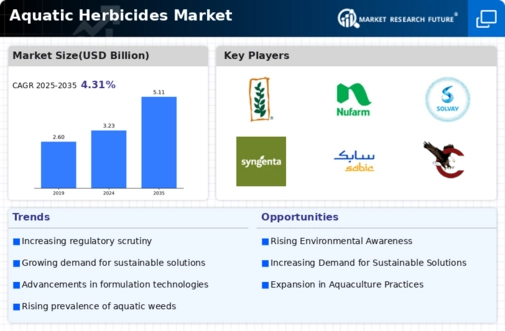
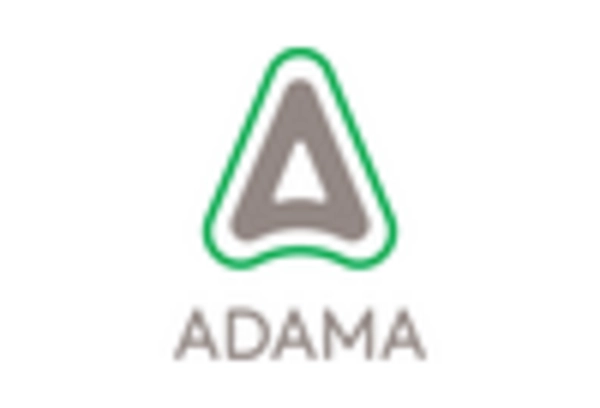


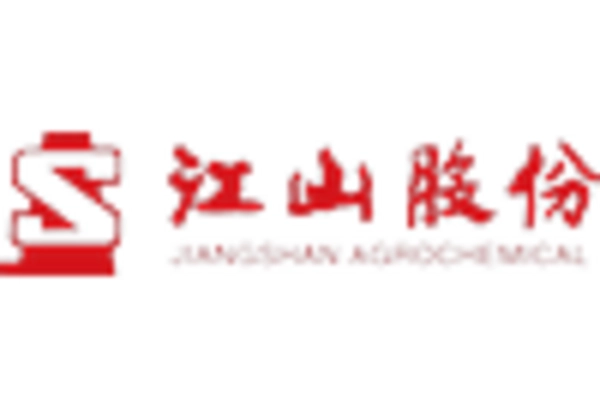
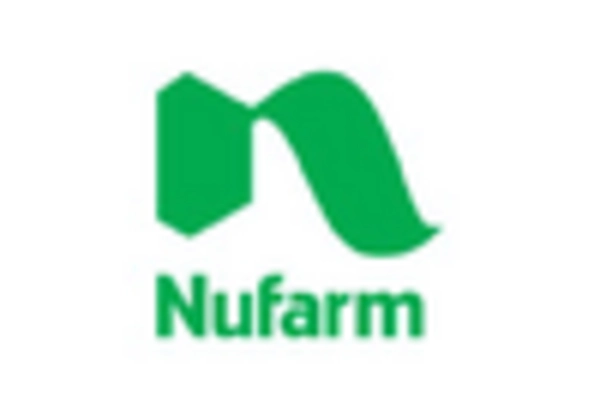
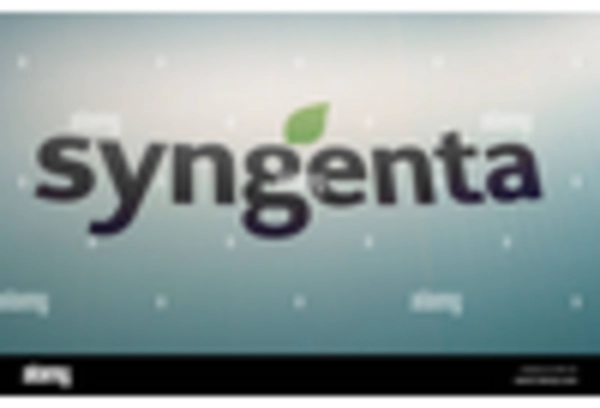









Leave a Comment